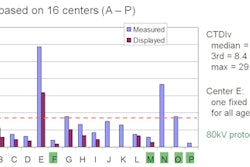An automated software algorithm called Valkyrie that extracts radiation dose information from CT exams and tracks it automatically may help imaging sites better follow patient radiation exposure and avoid overdoses, according to a study presented this week at the American Roentgen Ray Society (ARRS) meeting in San Diego.
Valkyrie was developed at the Weill Cornell Medical Center and Columbia University Medical Center, both in New York City, and seems tailor-made for a new era of caution and oversight regarding medical radiation dose delivered to patients.
The software can be used on any CT scanner regardless of manufacturer, and it represents a major improvement over the current methods of monitoring and tracking patient doses, according to lead researcher and Cornell radiologist Dr. George Shih, who discussed the study by telephone with AuntMinnie.com.
Cumbersome process
Radiation dose tracking is currently a cumbersome process that uses a manufacturer-generated screen-capture tool that contains the estimated dose exposure data expressed in dose-length product (DLP), Shih said. Radiation dose information is "burned" into the CT image header in picture rather than numerical form, making it difficult to share with other information systems.
"We weren't happy with the way we had to do [quality control (QC)] manually, and we realized there was an opportunity here," Shih said.
The group brainstormed with Cornell's computer science department in Ithaca, NY, to figure out what could be done to automate the process by which CT dose information is attached to the images. They came up with a method that extracts the information from the burned-in headers and enters it into a DICOM-compatible format.
"There are multiple steps in what we're doing, but globally, these types of problems are called text information extraction, and optical character recognition is part of it, but there's also much more," Shih said. The key step is extracting the numerical dose information from the image data, and "once we do that we can automate everything else," he said.
Some recent scanner models can handle part of the software's job, inserting the dose data into the record directly via the DICOM SR Dose Report standard, but Valkyrie works on every CT scanner and can potentially output to a broad range of applications for a broader quality control operation, Shih said.
The study presented this week looked at a random selection of 518 CT dose reports processed by the Valkyrie algorithm. A systematic review of those 518 studies found 100% accuracy of the extracted information based on the DLP output by the scanner.
Since the abstract was submitted, the group has performed nearly 2,000 scans with the system activated. The accuracy of the dose information extracted from the later scans has been validated only selectively, but in every case examined "there has been nothing found that was not correct," Shih said.
Still, plenty of room remains to expand the system's capabilities. For example, because the extracted CT dose descriptor -- the dose-length product -- is based on standard CT dose index (CTDI) measurements from standard-sized acrylic phantoms, the group has initiated a project to correct for various patient sizes by applying correction factors derived from CT dose measurements using a range of phantom sizes from 6 to 32 cm in diameter. So far they've gotten as far as the abdomen, the region where patient sizes vary most widely.
"Our electronic medical record contains information on patient size, height, and weight, which is sent through our RIS, then the modality, and then on to Valkyrie," he said. "Based on that information, we worked with the physicians and they came up with a correction for patient size." Correction factors will eventually be developed for the rest of the body.
Preventing radiation overdose
Another key job for the system is preventing the kind of radiation overdoses that have made headlines in California and elsewhere recently.
"Our first focus was to create an automated QC system where we set thresholds for each type of exam, and we're still fairly early in the process," he said. Essentially there will be thresholds for head, abdomen, chest, etc., and if a scan dose were about to exceed the threshold, the system would automatically send an alert to a radiation safety team.
"That's actually up and running, but we're still figuring out what optimal thresholds are," Shih said. Setting up an alert system presents "a lot of confounding factors" due to variability in patient sizes and scan protocols that might require an extra phase, for example.
"The immediate benefit is to avoid having patients overexposed," Shih said. "We want to catch the scans that were not set up properly."
Eventually the system will allow patients to keep track of their dose information in their personal health records and easily communicate that information to their healthcare providers. Patients are getting their healthcare in many different facilities now, so enabling physicians to get recent exposure information on their patients before the visit will be invaluable, Shih said.
Finally, the dose information and the research that can be done with Valkyrie will be more powerful the more people start using it, he said.
"We want other people to use Valkyrie, and hope to at least offer it to other academic centers who are interested in doing research with us," he said. "I think the more people who use this, the more valuable the radiation data becomes, and you have a better picture of the population."
By Eric Barnes
AuntMinnie.com staff writer
May 3, 2010
Related Reading
MITA unveils radiation dose warning system for CT scanners, February 25, 2010
FDA staff says agency may need new device powers, February 22, 2010
Congressional hearings on medical radiation rescheduled, February 19, 2010
Congress sets hearings to review medical radiation, February 8, 2010
ASTRO commits to patient protection plan, February 4, 2010
Copyright © 2010 AuntMinnie.com




















